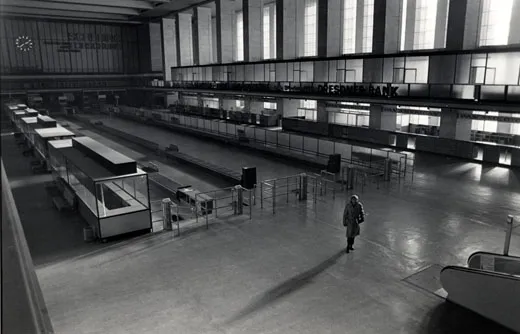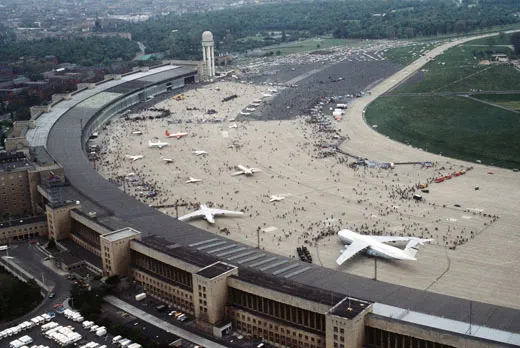Above & Beyond: The Village of Tempelhof
Above & Beyond: The Village of Tempelhof
/https://tf-cmsv2-smithsonianmag-media.s3.amazonaws.com/filer/ON08_AandB_Main_388x247.jpg)
As a U.S. Army Infantry sergeant, I arrived in West Berlin in 1956 on a troop train, but the divided city was open to commercial air travel almost as soon as World War II ended. American Overseas Airlines began service in 1946, flying into Tempelhof airport. A Nazi-era marvel of modern architecture and engineering, Tempelhof features a cable system that suspends a protective roof over the semi-circular arrangement of aircraft arrival gates. Nothing like it had been built before. Construction began in 1936—and is still incomplete.
Raymond Russell, 89, flew for AOA when it started flying to the airport. (AOA was bought by Pan American World Airways in 1950.) He recalls landing on a runway with steel plates here and there covering the bomb craters. Russell, who landed at Tempelhof for the last time on December 14, 1979, says architecture is not the only feature making the airport extraordinary. “Tempelhof was the most unusual because of its location in the center of Berlin,” he says. “This necessitated an approach between apartment buildings.”
The airport’s history also sets it apart. On July 4, 1945, a U.S. Army Air Forces Fairchild C-2 landed at Tempelhof. The ramp dropped, and off came a Jeep driven by Corporal Terry Mohr of the 82nd Airborne Division. A general exited the C-2 cabin and got in the Jeep. Mohr (who still lives in Berlin) drove through the ruined city to the barracks of Hitler’s Leibstandarte (Bodyguard Regiment), formerly the Prussian West Point, which the Soviet army had occupied since April 28. The Soviet flag was taken down and the U.S. flag went up. Thus began the U.S. occupation of West Berlin.
Tempelhof became famous in 1948 as an early battleground in the cold war. On May 24, the Soviets blockaded Berlin in an attempt to force out the Western allies (the United States, France, and Britain). The three countries responded with the Berlin Airlift, supplying by air West Berlin, an island surrounded by communist East Germany. A transport landed at Tempelhof every 90 seconds.
But what made Tempelhof extraordinary to me was its culture. After I was freed from Army service, I became a journalist and stayed on in West Berlin as a reporter for most of the cold war. Journalists in West Berlin were accredited as part of the U.S. Mission and received a Military Privilege Card similar to one soldiers carried. We had access to all allied military installations, including Tempelhof, which besides being a busy international airport was a military base. Tempelhof created a small, self-contained, friendly village that included in its confines nearly everything one needed for a good life, and where everyone knew everyone else. I had a post office box at the Tempelhof Army Post Office. I played on the Pan Am basketball team (always short-handed) in the Tempelhof lunchtime league.
A jogger, I ran Tempelhof’s inner perimeter. Once, in 1968, I looked up at a landing airplane and saw it had the letters LOT, which stood for the Polish national airline. Polish airliners are not allowed into Western airspace. Skyjacked! Still in my jogging clothes I reported the story, which included an interview with the base commander. He had learned that for one of the stewardesses, it was the second skyjacking to Tempelhof. “If she gets skyjacked again,” he said, “I’m going to make her a member of the officers’ club.” So many skyjacked LOT airliners landed at the airport that the joke around the field was that LOT stood for Land on Tempelhof.
The city’s unusual isolation made it attractive to young people from Western Europe and the United States. American kids found jobs at Tempelhof handing out towels in the base gym, waiting tables in the officers’ club, and washing dishes in the enlisted men’s club. Twenty hours a week earned them the treasured Military Privilege Card, which permitted the bearer to place on his or her car an American Forces license plate. Cars bearing this plate could not be searched by the Communist People’s Police on the other side of Checkpoint Charlie, the crossing point used by foreigners and the allied forces. Several card holders earned large sums by smuggling people out of East Berlin in their trunks.
Annually, Tempelhof threw West Berlin’s most popular party: a two-day open house. The Air Force flew in fighters for display, Pan Am opened an airliner for tours, and the Army dropped paratroopers. American social, charitable, and patriotic groups manned food and beverage stands to raise money. Attendance was regularly over a half-million.
From 1945 to 1990, Berlin remained occupied by British, French, Soviet, and U.S. air and land forces, and it was with their permission the Berliners governed the West and East halves.
Berlin was the focal point of the cold war, and throughout it, some activities continued without interruption, including commercial aviation at Tempelhof. All flights into the city were monitored by representatives of the three allies and the Soviets. Private aviation was forbidden, and only airlines of the Western allies could provide service to West Berlin (Pan Am, British European Airways, and Air France, as it turned out).
When a West German pilot flying his small airplane from southern to northern Germany was blown off course by a storm, he landed at Tempelhof—which was illegal, as was his flight over East Germany (and you can bet East German and Soviet air defense heads rolled). While the pilot was free to return to West Germany, the Soviets demanded the airplane be turned over to them. The allies refused. The French suggested they paint French markings on the airplane and fly it out. Finally, the wings were removed and loaded with the fuselage onto a U.S. transport and flown out—at the expense of the owner.
One Christmas Eve, the tower chief, Sergeant Parker Smoak, passed a “permission to land” request to the allied air representatives. Each officer read, signed, and passed it on. When it got to the Soviet officer, everyone wondered: What would he do? Finally, he shrugged, grinned, and stamped. Permission to land at Tempelhof was granted to Santa and his reindeer.
In 1975, a new airport in the French sector of Tegel opened, and civilian air traffic moved there. Tempelhof languished. It may have been the only U.S. Air Force base that never had an airplane assigned to it. Many of the 500 airmen and -women on the base did intelligence work at a radar post, listening to Eastern Europe. A daily courier flight came in from West Germany. Occasionally a Military Air Transport Service airplane arrived from South Carolina. The field was mostly used by the Army helicopter unit patrolling the Berlin Wall.
The 1990 reunification of Germany ended the Pan Am-British Airways-Air France monopoly on Berlin. Small carriers were permitted to fly to Brussels or Sylt, a popular German vacation island in the North Sea. The U.S. flag at Tempelhof came down in the summer of 1994.
In a 1996 decision that has riled thousands of Berliners, the city’s governing body, a coalition of Socialists and former Communists, announced plans to close Tempelhof. But the opening of the replacement airport, Berlin-Brandenburg International (the old Communist airport at Schoenefeld), keeps being postponed, and overruns have doubled the original estimate of 500 million Euros (about $750 million) for the opening. On October 31, the last airplanes will land and take off from Tempelhof.

